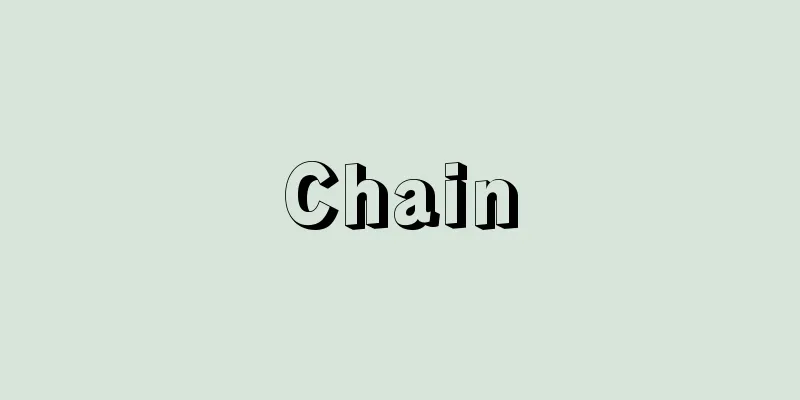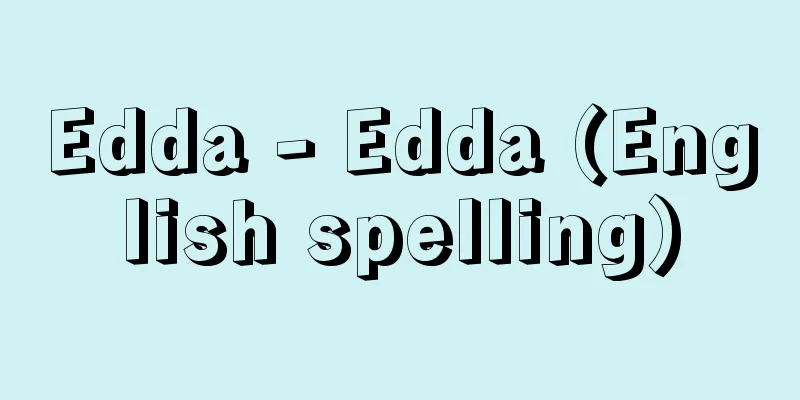Chain

|
A chain is made by connecting a number of links made of metal or other materials together. It is also called a chain. There are many types, from those used for jewelry and watches to those used for mooring ships, for hanging objects such as chain blocks and cranes, for pulling objects such as escalators, and for power transmission such as in bicycles. The size of the links varies from 1 or 2 millimeters to several tens of centimeters, and the length of the chain also varies from a few centimeters to hundreds of meters. It has a wide range of uses, and is made of a variety of materials and shapes depending on the purpose. [Hidetaro Nakayama] Industrial ChainsChains are used for mooring ships, chain blocks, cranes, power transmission for various machines, etc. They are usually made of mild steel, malleable cast iron, or cast iron, and consist of oval, rectangular, or two-sided links reinforced with a cross beam in the middle. The manufacturing method for chains varies depending on the material used. In the case of mild steel, a ring is first made by forging, and another ring with an opening is prepared, and the open ring is fitted into the two rings, and the opening is joined by forging. By connecting rings one after another in this way, a chain of the appropriate length is made. In the case of cast iron, two rings are first made by casting, and these two are placed into a mold, and a third ring is cast to fit into the first, and the chains are then joined. Chains for ships are generally large, and include anchor chains attached to anchors for mooring, steering chains used for steering, and cargo-handling harnesses. Anchor chains are usually stud-link chains with a cross beam in the center of the loop. Since chains for ships are related to the safety of the ship, there are rules governing the size, length, strength, etc. of the chains. Large ships use high-strength cast steel or electrically welded chains. Steering chains use short-link chains with no cross beams in the loops, and there are also rules for these. For cargo-handling, the size and thickness of the loops are selected according to the nature and weight of the cargo being handled. Chains for power transmission include ordinary chains with linked links, as well as cheaper types such as roller chains, silent chains, and pin chains for low-speed use. [Hidetaro Nakayama] Chains and ropesSteel ropes (ropes made from steel wires) are used for the same purpose as chains. Although chains are several times heavier than steel ropes for the same load, they have great flexibility overall, making them convenient for winding around pulleys and reeling into spools. However, for pulling applications such as cable cars and ropeways, steel ropes are used exclusively due to their length and weight. Steel ropes have as thin wires as possible so that they can bend easily, and the core contains cotton or other fibers, so they have the disadvantage that they are prone to wear and tear when hung on pulleys, and they also corrode quickly, especially when used underwater. Chains have the advantage that the length of the entire chain can be adjusted as needed by removing the links, making them convenient because when they become worn, only that part can be replaced. [Hidetaro Nakayama] Jewelry ChainGold chains have been used as necklaces in the West since the 4th to 2nd centuries BC. In Greece, goldwork had been developed since ancient times, and intricate gold chains were made and worn around the neck or arm, or as pendants. Goldwork was passed down from generation to generation and gradually developed, leading to the production of elaborate chains for jewelry. During the Renaissance, braided chainwork was also made, and gold chains for jewelry were used for payments and gifts in the same way as currency, and became a form of wealth. From around 1830, long gold chains were worn around the neck or to have watches tied to them. In modern times, they are used for bracelets, haori strings, necklaces, glasses, pocket watches, etc. Chains can be made from materials such as gold, silver, platinum, and white gold, and there are many different ways to weave the chains, including kihei, shimenawa, snake eye, square ring, diagonal, oval, torpedo, and other combinations and modifications of these. [Hidetaro Nakayama] ©Shogakukan "> Main types of chains (for jewelry) Source: Shogakukan Encyclopedia Nipponica About Encyclopedia Nipponica Information | Legend |
|
金属その他の材料で環(かん)をつくり、これを多数つなぎ合わせたもの。チェーンともいう。装身用、時計用から船舶係留用、チェーンブロック、クレーンに代表されるつり下げ用、エスカレーターなどの引張り用、自転車に使われている動力伝達用など種類も多い。環の寸法は1、2ミリメートルから数十センチメートルのように大きなものまでさまざまで、鎖の長さも数センチメートルの小さなものから数百メートルという大きなものまである。使用範囲も広く、目的により材料も形もさまざまある。 [中山秀太郎] 工業用鎖船舶係留用、チェーンブロック用、クレーン用、各種機械の動力伝達用などの鎖。普通、軟鋼、可鍛鋳鉄あるいは鋳鉄でつくられ、楕円(だえん)形、長方形、またはそれらの中央に横ばりを入れて強化した環からできている。鎖の製作方法は、使用する材料によって異なる。軟鋼の場合には、まず鍛造により環をつくり、もう一つ別に口のあいた環を用意し、二つの環に開口した環をはめ、あいている口を鍛造により接合する。このようにして次々と環をつないで適当な長さの鎖をつくる。鋳鉄の場合にはまず鋳造で環を2個つくり、この2個を鋳型に入れ、それにはまるように第三の環を鋳造してつなぎ合わせる。 船舶用の鎖は一般に大きく、錨(いかり)につけて係留するアンカーチェーン、舵(かじ)取りに使われる操舵(そうだ)チェーン、荷役用のもっこなどがある。アンカーチェーンは普通、環の中央に横ばりを入れたスタッドリンクチェーンが用いられる。船舶用のチェーンは船の安全性に関係があるので、チェーンの寸法、長さ、強さなどについての規則が定められている。大型の船には強度の高い鋳鋼製あるいは電気溶接製の鎖が用いられる。操舵チェーンには環に横ばりのないショートリンクチェーンが用いられ、これらについても規則が定められている。荷役用には、扱う荷物の性質、重量などによって環の大きさ、太さが選定されて使用される。動力伝達用の鎖としては、環を連結した普通の鎖のほかに、ころ入り鎖、音なし鎖、低速用としてはピン鎖など安価なものが使用される。 [中山秀太郎] 鎖と鋼索鎖と同じ目的に使われるものに鋼索(鋼線でつくられた綱)がある。同じ荷重に対して鎖は鋼索よりも数倍の重さがあるが、全体としては大きなたわみ性があり、滑車への巻掛け、巻胴への巻取りに便利である。しかし、ケーブルカーとかロープウェーのような引張り用には、長さと重量の点からもっぱら鋼索が使用される。鋼索は容易にたわむことができるように、なるべく素線を細くし、芯(しん)には木綿などの繊維を入れるので、滑車に掛けたりすると摩耗、切断しやすく、とくに水中で使用すると腐食も早いという欠点がある。鎖は、環を取り外すことによって鎖全体の長さを適当に調節できる特長があるから、摩耗したようなときには、その部分だけ交換できるので便利である。 [中山秀太郎] 装身用の鎖紀元前4~2世紀ごろから西洋では金の鎖が首飾りなどに使われていた。ギリシアでは古代から金細工が発達し、複雑な金の鎖がつくられ、首や腕の周りなどに巻き付けたり、ペンダントにして首から下げたりした。金細工は多くの人たちによって受け継がれてしだいに発達し、精巧な装身用鎖がつくられるようになった。ルネサンスのころになると組紐(くみひも)式の鎖細工もつくられ、装身用の金の鎖は貨幣と同じように支払いや贈り物にも利用され、一つの財産ともなった。1830年ころから長い金の鎖を首の周りに巻いたり、時計などを結び付けて用いられた。現代では腕輪、羽織の紐、首飾り、眼鏡用、懐中時計用などに使われている。鎖の材料としては金、銀、白金、ホワイトゴールドなどがあり、鎖の組み方も喜平(きへい)形、注連縄(しめなわ)形、蛇の目形、角環(かくかん)形、斜子(ななこ)形、小判形、水雷形などのほか、これらの組合せ、変形されたものなど多種類ある。 [中山秀太郎] ©Shogakukan"> 鎖のおもな種類(装身用) 出典 小学館 日本大百科全書(ニッポニカ)日本大百科全書(ニッポニカ)について 情報 | 凡例 |
Recommend
Gorgon - Gorgon (English spelling)
(1) A monster from Greek mythology. It refers to ...
Perkunas (English spelling)
...The following names of gods are abbreviated as...
Perugio, M.de (English spelling) PerugioMde
...However, much remains unclear about the actual...
Morinaga arsenic milk poisoning incident (Morinaga arsenic milk poisoning incident) - Morinaga arsenic milk poisoning incident
In 1955, an incident of arsenic poisoning occurred...
Apartheid - Apartheid (English spelling)
Afrikaans (the official language of the Republic ...
environmental pollution
...The causes of pollution vary depending on natu...
Rhinesomus gibbosus (English spelling) Rhinesomus gibbosus
...The cross section of the body is pentagonal. T...
Restoration of Imperial Rule - Taiseihokan
"Taisei" means the government of the wh...
Hemochromatosis (English spelling) h(a)emochromatosis
A disease in which large amounts of iron are depos...
Zou Rong; Tsou Jung
[Born] Guangxu 11 (1885) [Died] 1905.4.3. A Chines...
Nguyen Dynasty - Nguyen Cho
The last dynasty of Vietnam, with its capital in H...
Masatake Abe
Year of death: September 17, 1704 (October 15, 170...
Caroline - Caroline apple
...The inhabitants are undoubtedly immigrants fro...
Ascension - Shoten (English spelling) Ascention
In Christianity, it means ascending to heaven wit...
Azacyclopropane - Azacyclopropane
…Ethylenimine is also known as azacyclopropane. I...









